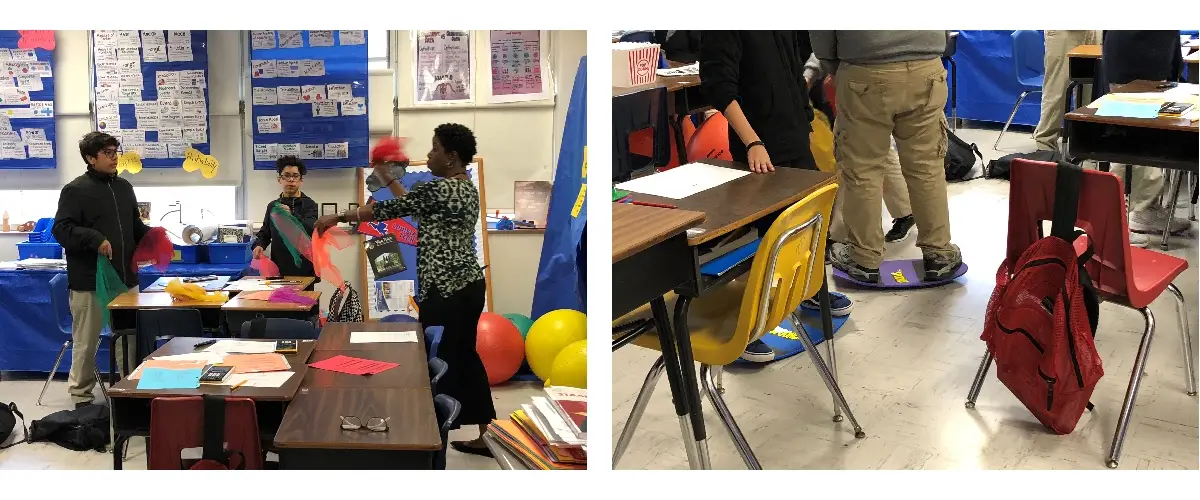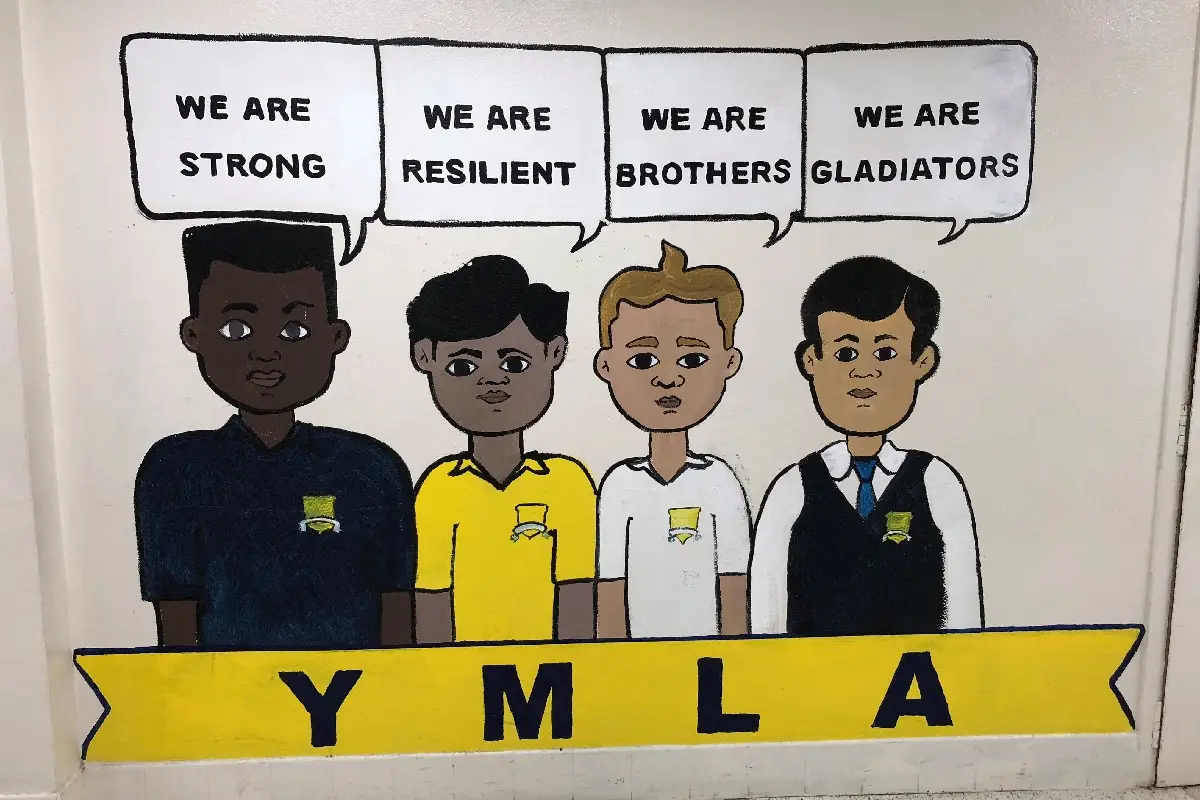So far in this gender series, I’ve introduced you to Cistercian Preparatory School and Solar Preparatory School, two single-gender schools in our area. In my quest to continue learning about how gender plays a role in education, I visited one other single-gender campus. It’s called Young Men’s Leadership Academy at Florence Middle School (YMLA), and it’s located in Southern Dallas. It’s in its second year as an all-boys campus and has 950 students in 6th through 8th grades. About 98% of the students are kids of color – the biggest populations are Latino and African American, approximately 75% Latino and 20% African American. About 98% of students qualify for free or reduced lunch, a benchmark indicator for poverty. It is a Dallas Independent School District public school with an attendance zone, meaning it’s not a magnet or choice school. Girls in the attendance zone attend school in nearby Balch Springs.
I toured the school with Kevin Malonson, who is the single gender coordinator of the school and helped with the transition from a co-ed school to an all-boys school in 2016.
So now that you know about the school, I want you to take a moment to imagine what it might be like to enter a middle school with 950 11-14 year old boys. What do you imagine it would sound like, look like or feel like?
I don’t know what you’re picturing, but I expected a lot more chaos than what I saw at YMLA. It wasn’t that boys were rigidly walking in straight lines, like some movie portrayal of a boarding school. In fact, the boys were laughing and jumping around the halls with friends during passing periods. But it certainly wasn’t chaos.
Mr. Malonson and I peeked into the art class and saw boys working quietly and independently on tablets, leaning over to a peer to ask a question or discuss something. As we walked down the halls, we saw students in class, listening to their teachers or quietly engaged in their work.

Every detail of the school is intentional. When they transitioned to an all-boys school, they consulted with experts who taught them what color lights to use in the building that help boys learn best. They figured out ways to add movement into the day, and they studied brain development. Mr. Malonson started standing next to students instead of across from them to talk to them. He stopped saying things like, “What are you supposed to be doing?” when he saw a student in the hallway, and instead just started a conversation to check in on them.
Mr. Malonson’s philosophy is, “You can be you. Period.” Boys feel free to be themselves at YMLA. The dance group is growing and one student I met was thrilled to be accepted into a prestigious arts high school for the next year, even though he had just learned how to dance that year. Several students identify as gay, and it is a total non-issue in terms of peer interaction. Mr. Malonson gives me several examples of students who may be stereotyped at another school but who are welcomed and even important peer leaders at YMLA.
As we walked up to one room to peek in, we heard the teacher say, “Alright, that’s a lot. Let’s take a brain break!” We looked in as students stood up and walked around the room to grab the object of their choice. Some students rocked on a balance board, others went to the back corner to pick up scarves and toss them into the air. The teacher, Mrs. Richardson I was told, showed them how to toss them back and forth to each other as a way to focus their energy. Mrs. Richardson also said, “This isn’t even one of my classes! These are Pre-AP students coming in to do extra work.”


After the bell rang, we took a minute to ask Mrs. Richardson some questions. I asked, “How is teaching here different from working at a co-ed school?” She said that the boys need more hands-on opportunities. She said, “They gotta touch it and feel it” and showed me a supply cabinet that is just for students. They can grab what they need whenever they need it. She also added that the boys know what they need to focus on and how they best focus. In a co-ed school, she believes that boys this age spend more time trying to impress girls, and that girls wouldn’t be as comfortable bouncing on the large balls or using the balance boards. Having just boys at the school allows them to be themselves and focus their attention on learning.
Mr. Malonson used a word I heard many times during my morning at YMLA: brotherhood. He said the boys do fight, but they fight like brothers. They care about each other. He said he used to watch them fight and push each other and it drove him crazy. He then said he learned that the kids just don’t really know how to touch each other appropriately. They weren’t roughhousing to fight, they were just playing around and that’s how they communicated with each other. When they did escalate to a fight, he saw that they weren’t actually mad at each other. They were just learning how to communicate, and physical touch was part of their language.
Then he said what I think might have been the most profound comment of the morning. One day he asked a student, “Why do you push your friends around? Why are you guys fighting if you’re not even mad at each other?” The student responded, “Because, Mr. Malonson. Here we feel safe. We are happy here at school, and this is how we have fun.”
Mr. Malonson was particularly struck by the use of the word “safe”. He spends time looking into contextual factors that are influencing the kids at the school. On this particular day, not too long after the Parkland High School shooting in Florida, he told me, “Since the Parkland shooting, there have been seven instances of gun violence in the community immediately surrounding the school.” Several high-profile violent incidents had also happened in that community, and many of the teachers personally knew one young woman who had recently been killed. Mr. Malonson says, “Paying attention to gun violence has helped me chill out.” He means that he used to jump on them for every little thing, but now he takes their whole context into consideration. He adds, “I’m here on purpose. I’m learning from them every day.”
I agree with Mr. Malonson. I learned something that day, and I think we all have a lot to learn from what faculty and staff are doing at YMLA. They’ve created a place where these boys – young men who statistically have so much against them – are happy and safe at school. They love to come to school. They are thriving in a brotherhood, a system designed to create a positive experience to help them be whoever they want to be. And at YMLA, I felt a profound sense of hope. A large mural greets you as you enter the school with four boys saying, “We are strong. We are resilient. We are brothers. We are gladiators.” These young YMLA Gladiators are learning how to be strong and resilient, and are also being given the incredible gift of brotherhood. This will serve them well as they continue on to high school and adulthood.

Share with
Related Resources